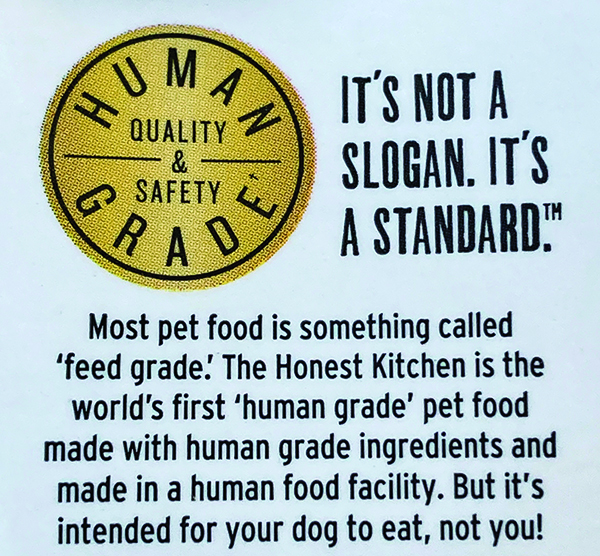
In a world of commercial pet food industry-specific jargon that is often incomprehensible to the average dog owner, the term “human grade,” which is popping up on more and more pet food labels, would seem to be self-explanatory.
So, what is human grade dog food? In reality, while the term is in increasing use on labels and in marketing materials, “human grade dog food” has no legal definition. The regulated – legal – terms that are used to discriminate between foods that are processed, marketed, and sold for human consumption and those that are intended for consumption by pets and other non-human animals are “edible” (humans can eat) and “inedible” (animals can eat). Let’s clear these waters so you understand the difference between the legal terms and the potential for wiggle room provided by the use of the more casual phrase “human grade.” It’s important to know the difference
Still, when you see the words “human grade” on a dog food package, these words do have important meaning and should be given careful consideration – not least because, as one might expect, it turns out that these foods have something special to offer.
See Human Grade Dog Food Brands
“Edible” Defined for Dog Food
Foods that are edible are handled, processed, transported and stored under a set of regulations that are specifically designed to keep products both nutritious and safe. In contrast, inedible foods enter a separate supply stream that is demonstrably more relaxed in its requirements for preserving nutrient value and preventing microbial contamination during handling and transport.
- Edible = Highly regulated; safe to consume as food; ends up in your supermarket.
- Inedible = Less intensely regulated; not considered safe for humans to consume as food; ends up in pet foods.
For obvious reasons, the terms edible and inedible, while technically correct, do not sit well with most pet owners. Enter the term “human-grade.” Although the Association of American Feed Control Officials (AAFCO) does not yet have a formal definition for this phrase, they have accepted its use in the pet food industry and allow it to be included on pet food labels provided the following standards are met:
“The term “human grade” represents the product to be human edible. For a product to be human edible, all ingredients in the product must be human edible and the product must be manufactured, packed and held in accordance with federal regulations in 21 CFR 110, Current Good Manufacturing Practice in Manufacturing, Packing, or Holding Human Food.”
Is Human Grade Dog Food Better?
So the bar is set very high for including this claim on a pet food label. Still, a number of companies are meeting these standards and are producing human-grade dog foods of a variety of types, including dehydrated, freeze-dried, and fresh cooked/frozen. The underlying assumption with all foods that carry a “human-grade” claim is that because of the types of ingredients, regulatory oversight, sanitation methods, and processing that are used, the end product will be safer and of greater nutritional quality than other foods that do not carry a human-grade claim.
Dog foods that are produced with human-grade ingredients have increased in number and popularity in recent years. In addition to containing food ingredients that are classified and handled differently than typical pet food ingredients, these products are usually less highly processed when compared with extruded kibble.
To date, there are only a few studies that have examined differences between traditional (pet-grade) foods and foods produced with human-grade ingredients. Here are short summaries of two of these studies:
- Digestibility Assay Study1. A validated biological assay was used to measure macronutrient digestibilities of a set of fresh-cooked, human grade foods (Just Food For Dogs). Although dry matter digestibility values were not spectacular (possibly due to fiber content), the protein digestibility and amino acid availability values – indicators of protein quality – were very high in the human-grade foods.
- Feeding Study with Dogs2. In this study, two varieties of Just Food For Dogs were compared with either an extruded dry dog food or with a fresh-cooked food produced with pet-grade ingredients. The two human-grade foods performed better than the extruded dry food and than the pet-grade fresh-cooked food. Digestibility values of the human-grade products were rock stars (greater than 90%), so less total food was needed to maintain dogs’ body condition, and the human-grade foods produced lower volume of feces.
Is Human Grade Dog Food Better Than Kibble?
Recently, another producer of fresh-cooked foods added their data to the growing science on this topic. The study3 compared the performance of four varieties of foods produced with human-grade ingredients (Nom Nom Now) to a chicken-based extruded kibble. The brand of the dry kibble was not identified. Dogs were fed each food for a period of 10 days. Collected data included measures of digestibility, energy, and fecal quality. The results of eating a diet of human grade dog food vs normal, dry dog food?
Digestibility values: When fed to dogs, the extruded kibble had significantly lower digestibility values for dry matter, protein, fat, and nitrogen-free extract (NFE, an estimate of carbohydrates) compared with all four of the fresh-cooked products. The differences were dramatic. For example, dry-matter digestibility of the kibble was about 82%. Dry-matter digestibility values of all four fresh-cooked foods were 90% or higher.
Protein: Similarly, protein digestibility of the kibble was about 85%. Protein digestibility values for the four fresh foods were between 92% and 94% (rock-star values again).
Feces: Dogs fed the fresh-cooked foods had significantly lower defecation frequencies (numbers of poops per day) and lower fecal volumes than when they were fed the kibble.
Human Grade Dog Food: Takeaway Points
As with the earlier studies, these results suggest that foods made with human-grade ingredients that are produced with minimal processing perform well when fed to dogs. This is information that dog owners can use when evaluating and selecting healthful foods for their dogs.
In my opinion, we still need controlled studies that tease out and quantify the respective influences of food processing versus initial ingredient quality. However, we do have a growing body of evidence telling us that both processing and ingredient quality matter in pet foods – a lot. (Remember, science loves replication.) Moreover, these papers, published in academic, refereed journals, and either conducted or supported by actual pet food companies, provide great examples of industry transparency that is sadly often in short supply. Which brings me to my soap box…
1. Oba PM, Utterback PL, Parsons CM, Swanson KS. “True nutrient and amino acid digestibility of dog foods made with human-grade ingredients using the precision-fed cecectomized rooster assay.” Journal of Animal Science 2020; 4:442-451.
2. Do S, Phungviwatniku T, de Godoy MRC, Swanson KS. “Nutrient digestibility and fecal characteristics, microbiota, and metabolites in dogs fed human-grade foods.” Journal of Animal Science 2021; 99
3. Tanprasertsuk J, Perry LM, Tate DE, Honaker RW, Shmalberg J. “Apparent total tract nutrient digestibility and metabolizable energy estimation in commercial fresh and extruded dry kibble dog foods.” Translational Animal Science, 2021; 5
Show Us the Studies on Human Grade Dog Food
The three previously described independent studies of commercially produced, fresh-cooked human-grade dog foods identified the companies and the brands that were tested. The data they reported included total digestibility values, protein/amino acid digestibility information, defecation frequency, and fecal scores (important to many dog folks), among other values.
The first study showed mixed results, while the latter two demonstrated some clear wins for human-grade foods. Moreover, although there were limitations, one study helped to tease apart the influence of ingredient quality versus that of processing. This is all good, practical, applicable information needed by dog folks and nutritionists alike.
So, here’s my beef (pun intended).
A common and highly (overly) shared assertion today regarding pet food selection centers on nutrition research and who exactly is doing that research. A frequent form that this “advice” takes is something along these lines (I’m paraphrasing):
“It is the large companies that employ nutritionists and that are conducting all of the research on pet food and nutrition. Therefore, consumers should trust those companies to produce safe and nutritious foods.”
There is a problem with this belief: It is not true.
The type of information that we need to know about the foods that we select for our dogs is not being provided by the large multi-national companies. Really, it’s not.
In contrast, in recent years, academic researchers (and to a lesser degree, small companies) have been providing us with boatloads of practical information about dog nutrition, pet foods, and pet food ingredients. The published research includes evidence regarding protein quality, the digestibility of dried-protein meals, damage due to processing, fish oils, the type of starches that are used in pet food, new processing methods such as freeze-drying and freezing, the effects of high-pressure processing (HPP) on raw foods, the potential health risks of excessive copper, mercury, and contaminating thyroid hormone in pet foods, and most recently, data regarding the use of new ingredients such as insect proteins and human-grade ingredients.
In contrast, with the exception of a single paper (published by nutritionists with Hills) that questioned current protein levels in pet foods, I have found no published studies by the large companies that address the nutritional value, digestibility, ingredient quality, or safety of their foods or their food ingredients.
For all of the marketing gimmicks, label claims, and emotional appeals that we hear from the multi-national corporations regarding the superiority of their products, where are the studies that report digestibility values, protein quality indices, and poop scores? Where are the data to support claims of nutritious and healthy foods? If we are expected to believe their marketing claims, then it is time for the companies (and their nutritionist spokespersons) to step up and show us the data.
Human Grade Dog Food Brands
The following companies manufacture and market foods for dogs that carry a label or website claim of “human grade” – a term that regulators have accepted for now as the same as the legal term, “(human) edible.” This means that all of the ingredients in the product must be human edible and the product must be “manufactured, packed and held in accordance with federal regulations in 21 CFR 110, Current Good Manufacturing Practice in Manufacturing, Packing, or Holding Human Food.” Some of these companies own and operate their own “kitchens.” Some have their products made in plants that also make human foods!| COMPANY INFORMATION | DESCRIPTION OF FOOD | COMPANY CLAIMS |
|---|---|---|
| CARU Vero Beach, FL (855) 330-2278 carupetfood.com | Canned food (stews), cooked in Tetra Paks. Made in the USA by a family-owned company. Eight varieties available. | “The U.S. Food and Drug Administration (FDA) has reviewed detailed documentation and concluded that Caru Natural Stews for Dogs are made with 100% human-grade ingredients. The FDA further concurred that these recipes are processed and handled in accordance with FDA regulations for human food. This means that we offer the only ready-to-eat dog food that is made with 100% human-grade ingredients and is prepared in a human-food-grade facility.” |
| EVERMORE PET FOOD Oakland, CA and Brooklyn, NY (718) 596-6788 evermorepetfood.com | Four varieties of cooked food, steamed and then frozen in vacuum-sealed pouches, are available. Made in Evermore’s own USDA/FDA-inspected kitchen in Oakland, CA. | “Gently cooked in a USDA ‘people food’ kitchen. Evermore uses only humanely raised meats; 100% grass-fed beef and lamb; free-range, antibiotic-free turkey and chicken; and eggs from pasture-raised chickens. Formulas include many organic ingredients, no GMO ingredients, and no ingredients from China.” |
| JUST FOOD FOR DOGS Irvine, CA (866) 726-9509 justfoodfordogs.com | Just Food For Dogs offers six varieties of cooked diets that are sold frozen in sealed pouches and eight “Pantry Fresh” stew-like varieties that are cooked and sold in Tetra Paks. For an additional, one-time formulation fee, owners can also have the company’s veterinary nutritionists customize a diet for your dog. | “Our food is crafted by hand in our open-to-the-public kitchens that you can visit, as well as in our own kitchens in Irvine, California, and New Castle, Delaware .... Human-edible ingredients. All of our daily diets for dogs have passed AAFCO-protocol feeding trials at Cal Poly Pomona. JFFD is the first pet food company ever to conduct humane feeding trials at a major university using faculty and student dogs living happily in their own homes.” |
| NOM NOM NOW Oakland, CA (415) 991-0669 nomnomnow.com | Four varieties of food are cooked in vacuum-sealed pouches and then frozen and shipped direct to consumers. Made in Nom Nom Now’s own kitchen facilities in Nashville, TN, and Pittsburg, CA. | “Every meal is prepared fresh in kitchen facilities we own and operate in Nashville, Tennessee, and the San Francisco Bay Area .... We only use whole-food ingredients, processed in the USA and fit for human consumption.” |
| NULO Austin, TX (512) 476-6856 nulo.com | Three canned food varieties – Nulo’s “Challenger” Stews – are cooked and sold in Tetra Paks. (Note that Nulo’s canned foods that are cooked and sold in standard cans are not human-grade.) | “100% human grade. Produced in a human-food facility.” |
| OLLIE New York, NY (844) 886-5543 myollie.com | Answer an online questionnaire about your dog first; then pricing for the four varieties offered by Ollie becomes available. Food is packaged in “modified atmospheric packaging” that is airtight to keep the fresh-cooked food fresh; refrigerate after opening. | “Custom meal plans: We tailor your dog’s plan based on their weight, age, breed, activity level, and allergies, recommending a precise portion according to how many calories they need.... Human-grade: You could eat it with a fork. (But save it for your pup!).... Minimal processing: Whole foods, gently cooked to preserve nutrients.... We carefully source our ingredients, cook them at low temperatures in small batches at our facility in New Jersey, and hand-pack them.” |
| OPEN FARM Toronto, Ontario (833) 399-3403 openfarmpet.com | Open Farm offers four varieties in its “Gently Cooked” line. The food is cooked “sous vide” in its sealed pouches, then frozen and shipped. Open Farm also has six varieties of “Rustic Stews,” cooked and sold in Tetra Paks. | “Gently prepared with minimal processing and 100% human-grade ingredients.” |
| PET PLATE New York, NY (855) 981-6109 petplate.com | Answer an online questionnaire about your dog first; then pricing will be available for two weeks’ worth of food. Each day’s serving is packaged individually in an appropriate amount for your dog. Four varieties available. | “Our meals are made with 100% human-grade ingredients and are kettle-cooked in a USDA kitchen, following the same safety standards used to make human food.... Every meal is hot-filled to ensure safety and flash-frozen to lock in freshness.” |
| SPOT FARMS Kings Mountain, NC (855) 880-7768 spotfarmspet.com | Two varieties of dehydrated, grain-free, “just add water” varieties are available. | “Human grade means that our products are made using only human grade food ingredients AND that our food is made to the same standards required for human edible food. You won’t find any feed grade ingredients like chicken meal, lamb meal, or fish meal here.... We believe knowing where your dog’s food comes from is just as important as knowing what’s in it. That’s why we go right to the source, working closely with small family farmers across the USA. Our farmers raise their animals the right way, feeding them an all-vegetarian diet and never using antibiotics.” |
| STELLA & CHEWY'S Oak Creek, WI (888) 477-8977 stellaandchewys.com | Six stew varieties, cooked and sold in Tetra Paks, are available. (Note that S&C’s canned foods that are sold in cans or plastic tubs, and toppers sold in pouches, are not human-grade.) | “Wholesome, nutritious, and 100% human-grade recipes cooked in small batches..... The animal proteins in our recipes are always grass-fed, cage-free, wild-caught, and farm-raised and responsibly sourced from trusted partners.” |
| THE FARMER'S DOG New York, NY (646) 780-7957 thefarmersdog.com | Answer an online questionnaire about your dog first; then the company recommends several customized recipes of food, cooked and sealed in pouches and shipped to you fresh. | “Real Food: Human-grade meat and veggies in simple recipes, made for dogs... USDA Kitchens: Safety and quality never before available to pets.... Human-grade food in human-friendly packaging. Less processing, higher safety standards, and easy serving.... Your food is delivered to you within days of cooking. Never deep frozen. Never stored on a shelf for months.” |
| THE HONEST KITCHEN San Diego, CA (866) 437-9729 thehonestkitchen.com | Originally, The Honest Kitchen made dehydrated food mixes; you’d just add water before serving these complete and balanced diets to your dog. They still make *18* of these foods, including varieties that contain grain, are grain-free, and some that are limited-ingredient. Today, they also offer nine varieties of “Clusters,” a kibble-like food that is mixed, cold-pressed, and dehydrated; five varieties of “One Pot Stews,” which are stew-like canned foods cooked and sold in Tetra Paks; five varieties of “Butcher Block Pâtè,” which are loaf-style canned foods, also cooked and sold in Tetra Paks; and 13 “pour overs” and meal “toppers” – all of which are human-grade. | THK was first dog food to earn the right to label its foods as human grade, way back in 2003. “Unlike feed-grade pet food, which is a lower quality than human food, being human-grade means a whole host of extra measures to ensure the quality and safety standards for all our complete and balanced foods. Since our foods, supplements, and toppers are actually made in plants that conform to all human food standards, our quality-assurance program is designed to attest to the necessary standards that would apply if a human were to be the end consumer.... No matter how popular we become or how many products we offer, we’ll never move away from our original goal of bringing the highest quality standards of ‘people food’ to pets. It’s something we call ‘The Honest Difference.’” |
Related Articles
- Whole Dog Journal’s 2021 Approved Canned Dog Foods
- Whole Dog Journal’s Approved Dry Dog Foods for 2022
- Whole Dog Journal’s 2021 Approved Freeze-Dried/Dehydrated Dog Foods





A very well-informed article, thank you. I also recommend Marion Nestle’s books on the topic – especially how food companies skew the science of what we eat. She is a Professor of Nutrition, Food Studies, and Public Health at NYU, and also published books about pet food industry, which were very good reads.
What about Dr Marty’s freeze dried bagged food
Very well researched and presented article that confirms what I’ve been suspecting for a long time. Thank you for writing this article so that pet parents can understand the realities without having to consult a dictionary for every other word!
Thank you, thank you, thank you… for posting this for all to read. So helpful!!!
I have to wonder about the packaging used in those human-grade foods mentioned. Most are sold in Tetra Paks, and cooked and frozen in those same packages. Some Tetra Paks have been shown to leach more estrogen-like compounds (bad!) than #1 plastics. Some plastics also leach more bad stuff if they are heated and/or frozen. So, will be increasing cancer risk by feeding our dogs from these packages? Have the companies studied that?
There is one food variety that I have run across that is “restaurant quality”, their words, not mine. I can’t remember the brand but it is a specialty, fresh, refrigerated/frozen brand that is cooked. I have to think this means that it is composed of restaurant waste (i.e. from the plates of diners that are scraped into a vat prior to washing) and/or discard ingredients from restaurants that are slightly past their prime. What else could this designation mean? So, high quality but discarded and maybe no longer fresh and containing spices, salt and other ingredients not ideal for dogs. Not necessarily harmful and, I think, way better than dead, diseased, dying and putrid by products but not regulated enough to be ideal for canines.
Are there any of these products that you recommend? Just listing a dozen companies that manufacture ” human grade” dog food with each company’s claim about their products without weighing in isn’t very helpful.
I am feeding Raised Right, also human grade. Truffle and I are very happy with this food.
Is there a reason Raised Right is not included in your list?
Are there any of these foods that you would recommend?